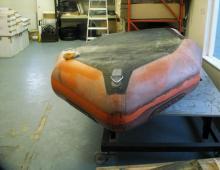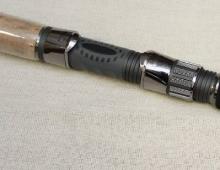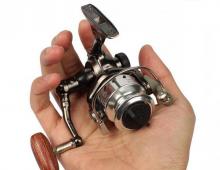How to choose a feeder rod, feeder tackle device
Feeder, as applied to fishing, is translated from English (feeder) as a "feeder". The idea to combine a feeder rod with a rig that would also include a feeder came to the mind of a smart Englishman in the seventies of the last century. Fans of "pulling the fish out of the pond" are quick-witted people. They immediately caught the prospect of fishing with a feeder, and it began to spread rapidly.
The advantage of a feeder rod over a regular bottom is that the bait is in close proximity to the bait. In addition, with each cast, part of the feed is washed out of the feeder and remains at the bottom, luring fish to itself. And the weight of the feeder contributes to self-cutting when biting.
Since that time, the feeder tackle has changed a lot. Trial and error led to the optimization of all attributes of the feeder rig from rod to leash. This article will focus on feeder rods. They are in the first place among all the attributes of this method of fishing.
Feeder tackle: device and design of a rod for a feeder
The main distinguishing feature of the feeder rod:
- Interchangeable top whip and multiple rings(up to twenty), through which the fishing line is threaded.
- Handle and several sections(3–5) are the same as in the spinning structure. The exception is Picker. It has two sections.
- Rod length in the assembled state ranges from 3 to 5 meters.
- Strength is directly related to the material, from which the prefabricated parts of the rod are made. These are mainly various synthetic composites.
- Cork is most often used for the handle. In another case, it is rubberized.
- Knees can be combined with each other in two ways. A spigot type spigot joint and a put over joint, in which the upper one is placed on the lower elbow. The second way is preferable.
Let's consider each of the details of the device in more detail, so that when choosing a feeder rod in the store there is no single chance to buy a low-quality product, or tackle that does not fit our fishing conditions.
Feeder rod test
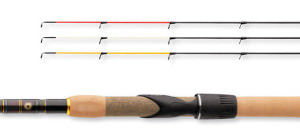
Heavy Feeder - heavy class feeder rod is the most common, allows you to fish with loads weighing up to 120 g, which is quite suitable for fishing on large rivers with a current, and on lakes, with ponds
This term refers to the maximum load on the form. Since the sinker in the feeder fishing method is the feeder, its size, and hence the weight, determines the length of the feeder rod, its strength and flexibility. Therefore, several classes of rods have been formed, each of which has its own feeder size.
- Ultra Light feeder, which is more commonly and more simply referred to as "Picker". This is a two-section rod up to three meters long. His test should not exceed 40 grams. Exceeding the calculated load during casting threatens with a fracture, from which no application of gypsum can save. Long distance casting is not possible in this case. The beauty of the "Picker" is that it is simply indispensable in the conditions of Russian small rivers with a barely noticeable flow, where you can’t calmly fish with a float rod, especially with wind with ripples on the water, and a simple donka is not so catchy.
- Light feeder "Light". This class of rods is designed for a maximum of 80 grams. The length of the three sections is 3 - 3.6 meters. Casting reaches 40 meters. The cargo can already resist the flow, which is beyond the control of the Picker. Accordingly, the place of fishing is selected.
- Medium feeder "Medium". Length - 3.6 - 3.8 meters. The maximum test is 100 grams. The rod is three-section, and essentially universal, because it allows you to cast up to 50 meters, and catch in the course of an average character.
- Heavy Feeder "Heavy". Less common class. The test weight reaches 120 grams, with a length of 3.6 - 4 mm. This class of rods is often equipped with an additional knee, allowing you to extend the blank up to 4.2 meters. This creates additional convenience when casting. Yes, and it is easier to fish with a long rod. If you raise it higher, then even a rocky edge will not be a hindrance.
- Extra Heavy Feeder The last of the classes. The characteristic is clear from the name. It can be equipped with a feeder up to 300 grams. Designed for ultra-long casts and for catching huge fish. Accordingly, their use is possible only on large bodies of water such as the Norwegian fiords, or wide rivers with beluga and, if any, are still somewhere.
Feeder rod build
In addition to strength, the flexibility of the blank is equally important. This characteristic also has subsections.
- Fast - fast build. Its feature is expressed in rigidity. In fast action rods, only the top and the first knee from it bend. Convenient for quick sweeps, which is why it got its name.
- Slow - slow action. He has a much softer personality. When stretched, the scaffold bends all the components, except for the handle. This allows you to reduce the load on the tackle when playing fish, which is sometimes very important.
- Progressive is a complex system. Rods with this action are also called "parabolics". The bending of the knees occurs in an increasing degree. First, the upper components are turned on, and with an increase in tension, all the others are turned on, turning the entire form into a parabola. Such rods are rare, because their cost exceeds the desire to purchase.
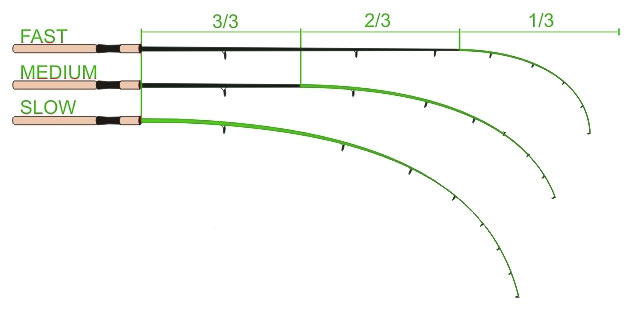
Quivertip (kvivertip) - removable tops
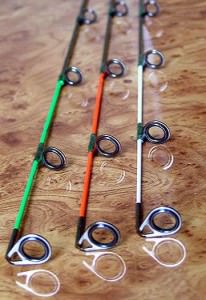
Removable tips of different softness are always supplied with the feeder to increase and decrease the sensitivity of the tackle.
Feeder rod tips require a separate description. As a rule, three or four thin tips made of monolithic synthetics are attached to each instance. Usually it is carbon fiber or fiberglass, painted in different bright colors for better visibility. The tops have a dual purpose. In addition to depreciation properties, they are assigned the duty of gatehouses. They are the first to react to a bite, notifying the angler about it. This explains the importance of their sensitivity.
They also have their own test indicators for stiffness. Due to the English origin of the fishing method, the ounce (28.35 gr.) is considered to be the test unit for the tip. To determine it, a weight clings to the tip of the tip, and when the bend reaches 90º, it is fixed. The number of ounces in the load becomes a numerical expression of the tip test. The marking of the test must be applied to her body. According to the characteristics are divided into three types.
- Soft quiver tip it is recommended to use for fishing in the absence of a current, or in reservoirs with a very weak current. For their manufacture, fiberglass is used. It is more flexible than carbon fiber.
- Middle- more suitable for not very strong flow, but the wind is not a hindrance to it.
- Hard. This type is made of carbon fiber and can be used when fishing in strong currents.
It must be said that these manufacturer's recommendations are of no particular importance. Quivertypes are not a continuation of the form. When thrown, they carry the most minimal load. And if the tulip does not overlap with a fishing line, then they cannot break from the load of the feeder. Their function is reduced to float - to react to a bite. And since the feeling of bite is expressed individually for each fisherman, then the selection of tips occurs according to the same principle.
Feeder rod rings
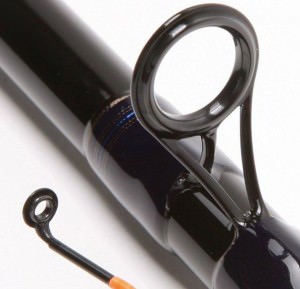
Choose feeder rods with rings coated on the inside with titanium nitride "Gold Cermet" or silicon carbide "SiC"
The characteristics of feeder rods will be incomplete if one more important detail is not included in it. These are rings. Since there are many of them, the characteristic features of the rings affect both the ease of casting and the preservation of the structure of the fishing line.
Rings are made from different materials, and not all are designed to use rigid forms of fishing lines. Passing through the rings, the running braid can damage their structure and further use of the rod will only bring trouble in the form of the impossibility of long-range casting and damage to the monolith of the fishing line by the barbs of the rings.
When buying a rod, you should definitely ask what ring inserts are used in it. Often, cermets are used for them with the application of titanium nitride "Gold Cermet" or silicon carbide "SiC". If the rings are without inserts, then it is better to immediately refuse to buy.
Video on how to choose a feeder rod, how to properly assemble and other subtleties of fishing with an English donkey.
- the choice of bait, lures, the right equipment and the search for a place to catch carp with a feeder.
Popular brands and prices for feeder rods
Mikado Black Draft Picker. Test - "Ultra Light feeder" up to 40 gr. Length 1.4 m. Made of carbon fiber. 2 sections. Connection of knees on the spigot type. Cork handle. Rings "SiC". Equipped with three quiver-types. Two fiberglass and one carbon fiber. Weight 187 gr. The price is 2630 rubles.
Shimano Aernos TeleFeeder.«Light feeder» 60 gr. Length 3.66 m. Designed in 2014. For the convenience of long-distance casting, it is equipped with an elongated handle. Five sections of telescopic connection, which is not typical for feeder rods. Three quiver types. Weight 225 gr. The price is 5810 rubles.
Browning Black Viper MK15."Extra Heavy Feeder" 250 gr. Length 4.5 m. Parabolic. Three knees with a transport length of 1.56 m. Three tips included. Weight 394 gr. The price is 13125 rubles.
The cost of rods, of course, does not bring joy, but prices have one feature. After some time, they are able to cause nostalgia for an unrealized opportunity. And what man, seized with passion, was stopped by the price? And how much does a fresh morning breeze cost, bringing from the shore the silty smell of fish that has not yet been caught ...
Leave your feedback about the feeder rods you fished with, what sensations did you experience, were there any problems with tackle?

